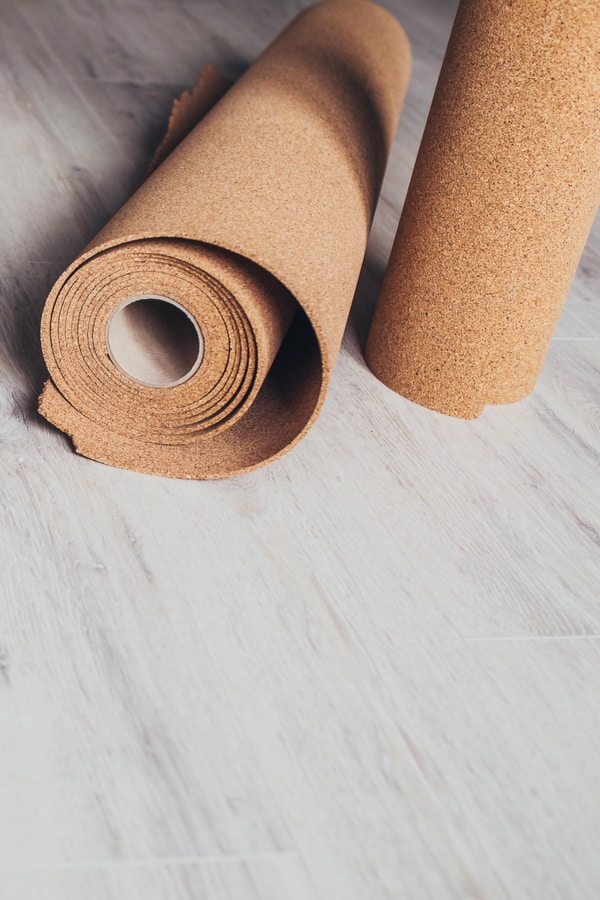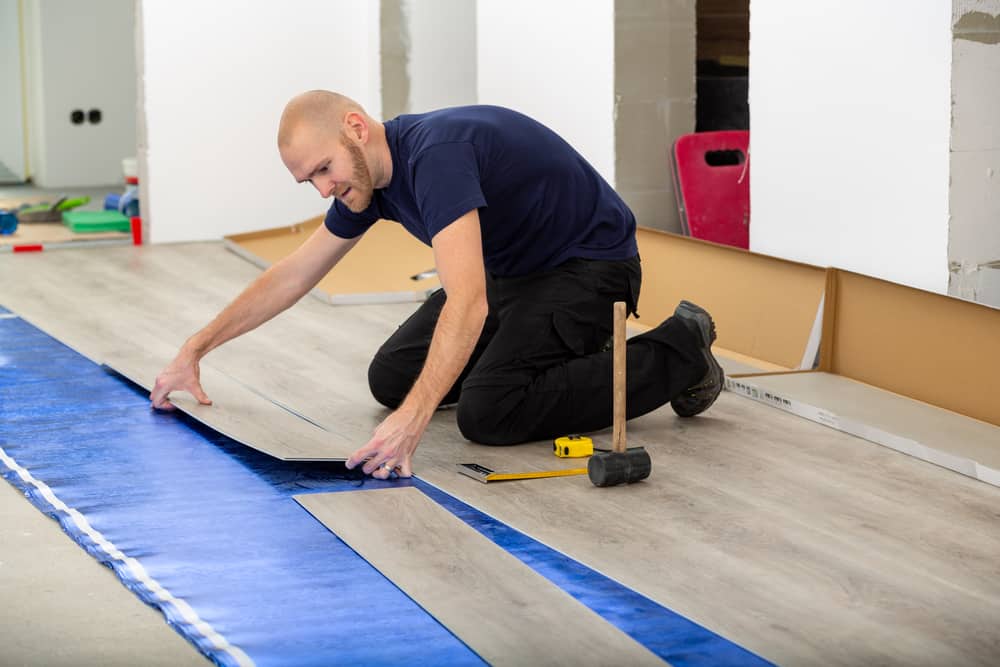When it comes to installing vinyl plank flooring, many homeowners will find themselves wondering whether to use an underlayment or not. Now, if you are looking to upgrade your current tile, wood, or concrete floor to the beautiful, hardwearing vinyl flooring, you may also be wondering the same.
And here is the truth; an underlayment is a great addition to any flooring project. But really, do you need underlayment for vinyl plank flooring?
Short answer – yes, a vinyl plank floor may require an underlayment. Keep reading and you will find out why.
Table of Contents
- How to Know If You Need an Underlayment
- When Does an Underlayment Help?
- Things You Need to Know About Installing an Underlayment
- Types of Underlayments to Use With Your Vinyl Plank Flooring
- How to Choose a Good Underlayment for Your Vinyl Planks
- How to Install Vinyl Plank Flooring Underlayment
- The Takeaway
How to Know If You Need an Underlayment
Before you install your vinyl planks, it’s important that you first understand your subfloor type and the purpose you wish the underlayment to serve. In addition, you ought to ask yourself these questions:
- Is your subfloor in good condition?
- Is it smooth and free of dents, bumps, and other flaws?
- Is it clean and free of dust?
If your subfloor is damaged, dirty, or full of bumps and you think that repairing, cleaning, or sanding it would be a lot of work, then it’s best to use an underlayment.
Also, think about the type of subfloor you have. If you are laying your vinyl planks on a concrete subfloor, an underlayment would be necessary, first, because it will offer extra cushion, and second, because it will act as a moisture barrier and keep water vapor out of the planks. An underlayment will also help keep your new flooring warmer when the cold weather sets in.
If you are doing your installation over a hardwood floor, you won’t need to worry about protecting your vinyl planks from water vapor, but you may still want to get an underlayment for extra caution or sound reduction.
The same is true when installing the planks over tile or linoleum. Moisture will mostly not be an issue, but an underlayment will help make the new flooring soundproof, all while providing an additional layer of cushion.
Also, keep in mind that some apartment complexes and Homeowner Associations may actually require you to have your flooring installed with a sound barrier.
So yes, you do need underlayment for vinyl plank flooring. If you are in the market for this flooring type, you may as well start looking up prices for different types of underlayments.
When Does an Underlayment Help?
If your brand of vinyl planks recommends using an underlayment, please do so, as not using it can result in issues during or after the installation. For instance, lack of underlayment can cause the flooring not to perform well or not to last for as long as it was meant to.
Most homeowners who skip the recommended underlayment usually end up regretting it because the floor usually develops a ‘clapping’ sound. This sound can come about when there is even only a one-millimeter difference in height along the plank’s length.
Also, as we mentioned, an underlayment can help prevent the vinyl planks from moisture. If you are installing the planks over a concrete basement, for example, the underlayment will not only keep moisture at bay; it will also help control humidity in the air, making the space more livable.
Things You Need to Know About Installing an Underlayment
- Even waterproof vinyl planks need an underlayment
That’s right! An underlayment can benefit almost any type of flooring. Remember, its job is not just to control water vapor; it also reduces noise and provides extra insulation.
- Vinyl planks with an attached pad may not require an underlayment
If your vinyl flooring has attached padding, you will probably not require an underlayment. However, your decision may vary based on the thickness of the planks, type of the subfloor, and your personal preference, so consider that too.
If you are not going to install underlayment, though, make sure the subfloor is clean, level, and in good condition; it will make installing the planks easier and keep the floor feeling soft underfoot.
- Underlayment can be paired with radiant floor heating
You may be able to use your underlayment with your floor’s heating system. However, it is important that you first check with the manufacturer. For the most part, if the underlayment is indicated safe for use with radiant floor heating, you are good to go.
Types of Underlayments to Use With Your Vinyl Plank Flooring
There are two types of underlayments that can be installed underneath vinyl planks – rigid underlayments and soft underlayments.
Rigid Underlayment
The rigid underlayment usually includes plywood and underlayment panels. Plywood is often the most commonly used type of underlayment in vinyl plank flooring installation.
Sheets of 4×8 foot plywood, usually ¼ to ½ inch thick tend to be an excellent flooring underlayment for many subfloors including wood, tile, and linoleum. The A-graded side is quite smooth, which makes it ideal even for the thinnest vinyl planks.
In the absence of plywood, underlayment panels can be used too. These usually come in 2×2 foot tiles and are great moisture and sound barrier. They are the most appropriate option if you are installing your vinyl planks on a concrete slab.
While a rigid underlayment is more stable and provides a better water vapor barrier, it also tends to slightly raise the height of your floor. If the underlayment is too thick, it may raise the floor too high that you would have to modify some parts of your house. For instance, you may need to trim your door frames so the door can open and close properly.
Soft Underlayment
Because of the obvious drawback of rigid underlayment we have talked about above, many people are now leaning more toward soft underlayments like sheets of cork or foam.
Usually, these are floating underlayments, meaning they are not adhered to or attached to the subfloor in any way. For people who move houses often, this can be an advantage because these underlayments are easy to remove and reinstall.
The only disadvantage of soft underlayment is that the material is usually not as sturdy as what’s used in plywood and other rigid underlayments. It may also not lock moisture out, meaning it may not be the best option for people with concrete subfloors.
Because it is soft, however, it is an excellent solution for installing vinyl planks on ceramic tiles, wood floors, and linoleum. It can also be laid over rigid underlayments to deaden sound and make the new flooring feel or sound less hollow underfoot.
Ultimately, the type of underlayment you choose will depend on the type of subfloor over which you plan to lay it and what you prefer. If you are working with a concrete slab, it would be best to look for a rigid underlayment. But if you are looking for something that can proof sound and make the floor feel softer underfoot, a soft underlayment would be a better option.
How to Choose a Good Underlayment for Your Vinyl Planks
The best underlayment for any type of flooring is one that is thin. While thicker underlayments may offer more cushion, the thicker underlayment is, the more likely it is to pose problems after installation.
This is especially true if other rooms have thinner underlayments. Transitions can be a problem if the floor level in one room is considerably higher than in the adjacent room.
Also, if a room has a low ceiling, a thick underlayment may pose a problem by reducing the height of the room. In some cases, you may even have to trim doors so they can open and shut properly.
How to Install Vinyl Plank Flooring Underlayment
While different types of underlayments may require different methods of installation, here is the most common procedure for laying an underlayment over a subfloor:
- Thoroughly clean your subfloor to get rid of any dirt and debris that may cause the underlayment not to sit properly on the subfloor. You can use a wet mop or vacuum cleaner. Make sure to allow the surface to completely dry before proceeding.
- Install the underlayment as directed by the manufacturer. Keep it as level as possible so your vinyl planks can also be level.
- Check to see if there are any spaces between the underlayment sheets or boards and close them with a seam filler before installing your vinyl flooring.
As you can see, installing underlayment for vinyl plank flooring is not a difficult task.
The Takeaway
If you came here to find out whether you need underlayment for your vinyl plank flooring, now you know that not having one can be disastrous.
An underlayment will act as a sound barrier, offer extra insulation, give better underfoot comfort, act as a moisture barrier in concrete subfloors, and provide a cleaner, smoother surface for you to lay your new flooring.
Get one that is as thin as possible to avoid shortening the height of your room or having to modify some parts of the room.


There is no mention of thin underlays as provided by Carpetright etc which comes in large rolls and has a peal off coating which has to be removed and I am presuming that the slightly sticky side is laid this side up and the whole tacked down with occasional staples. I did my bathroom and toilet some time ago and this had the same base ie floor boards all covered with hardboard and its been perfect so far. This time doing the kitchen and dining area with same tiles although these ones are more solid just not as flexible so hoping all will be well !!!
Hi there, I have a heated concrete floor, the water lines that run in the concrete, is it ok to use vinyl flooring and do I need a under payment? Tks
I would recommend underlayment for vinyl plank flooring. It will help protect the flooring and make it last longer.